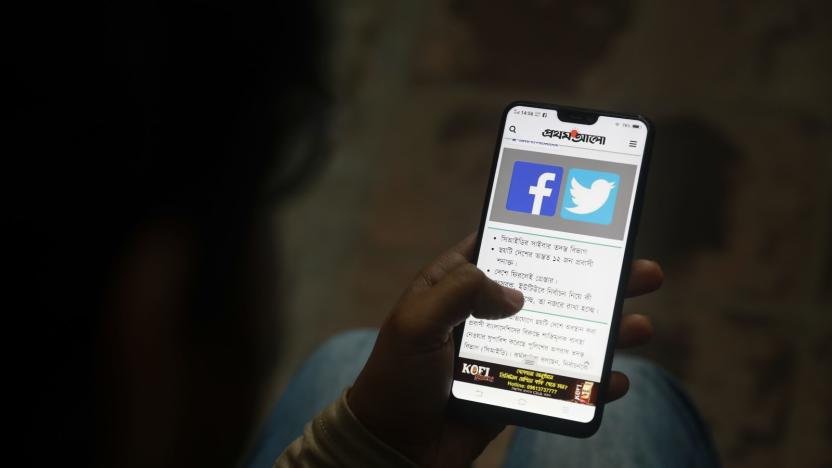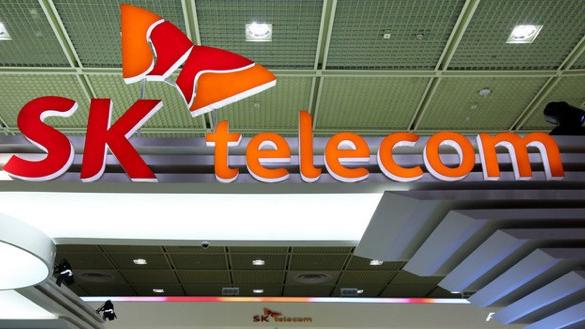MobileInternet
Latest

Bangladesh shuts off mobile internet ahead of election
The Bangladeshi government isn't just counting on Facebook and Twitter crackdowns to protect its December 30th parliamentary election. The country's Telecommunication Regulatory Commission has shut down 3G and 4G mobile data to "prevent rumors and propaganda" from skewing the vote. The measure took effect immediately and was poised to last through the end of election day.

Ookla: Minneapolis has the fastest mobile internet among US cities
If you live in or often visit Minneapolis, Ookla has good news for you: the company says that locale tops the list of US cities with the fastest mobile internet, with a mean download speed of 44.92 Mbps. Ookla, which analyzed data from its Speedtest app from the first half of the year, said Minneapolis' Twin Cities brethren Saint Paul was in second place, followed by Fort Wayne, Indiana; San Francisco; and Irvine, California. Atlanta and Pittsburgh followed those cities, while Minnesota was also the fastest state.

Bali plans to shut down mobile internet for its New Year
You might turn off your home internet or cell network on occasion to disconnect and have some down time, but it's likely that your country isn't doing it for you. According to The Guardian and the BBC, Bali is shutting off the net country wide for 24 hours this coming Saturday in recognition of Nyepi, or Balinese New Year.

Korean carriers to launch broadband-shaming 300Mbps LTE-Advanced network this year
Most of us in Europe and North America try not think about how much we're getting smoked by Asia in terms of internet speeds, but here's another reminder: residents in South Korea will soon enjoy 300Mbps wireless on carriers SK Telecom and LG's U+. That follows a similar effort by CSL in Hong Kong, which achieved the same speed by combining two 20MHz LTE bands. However, SK and U+ will use so-called LTE-Advanced 3-band carrier aggregation tech, marrying three bands to achieve the higher speeds. Before residents there can download the proverbial 800MB movie in 22 seconds, though, 3-band aggregation will have to be standardized globally and adopted by smartphone chip makers (Qualcomm's Snapdragon 805 chip is rumored to support it). While you're mulling that, SK Telecom will actually be showcasing even better 450Mbps tech in February at Mobile World Congress -- so enjoy your 75Mbps max LTE, citizens. Update: According to the Korea Herald, LG U+, the nation's number three carrier, will also deploy 300Mbps speeds along with SK Telecom sometime in 2014. The post has been updated to reflect that.

NTT DoCoMo's vision of '5G' wireless: 100x faster than LTE, but not until 2020
We knew good and well that Japanese carrier NTT DoCoMo would be divulging details about its 5G wireless plans at CEATEC, but the claims that we've stumbled upon here in Chiba are nothing short of bananas. Granted, the operator is making clear that its vision isn't intended to reach implementation until 2020, and it confesses that a 5G standard has yet to be ratified. That said, it's dreaming of a world where its network offers "1000 times the capacity and 100 times the speed as the current network." Representatives for the company told us that the challenge is going to be dealing with range limitations in higher frequency spectrum, but it plans to employ "high-frequency bandwidth by transmitting with a large number of antenna elements." The goal for looking so far forward? It's already seeing an insane appetite for video on networks that can barely maintain poise under the load, and the notion of transferring 4K content to the masses is going to require a substantial upgrade. CEATEC's known as a place that allows companies to dream big and aim for the fences, but we'll be honest -- we'd really, really prefer that 2020 arrived sooner rather than later. Mat Smith contributed to this report.

International Telecommunication Union: worldwide mobile subscriptions hit six billion in 2011
Last year, the UN's International Telecommunication Union (ITU) told us there were five billion mobile subscriptions worldwide at the close of 2010, and now it's reporting that at the end of 2011, that figure hit a staggering six billion. China and India account for one billion a piece, and it brings us ever closer to having the equivalent of one subscription for every person on the planet. (According to the CTIA, there are already more cellular plans in the US -- around 322 million -- than there are inhabitants.) In a stat-heavy release from the ITU, it also ranked the most advanced telecoms countries, with South Korea placing first, Japan eighth and countries in Europe filling the remaining spots. Interestingly, the number of global mobile broadband subscriptions now outnumbers fixed ones by two to one, and mobile internet services showed the biggest growth rates in 2011: 40% worldwide and 78% in developing markets. The ITU attributes the latter figure to the relatively high price of fixed access in these countries, and the increasing availability of mobile alternatives. The CTIA also commented on mobile broadband use, reporting that from July 2011 to June this year, Americans consumed 104 percent more data -- no doubt due, in part, to people taking advantage of expanding 4G coverage. As usual, we've given you the cheat sheet, so if you'd like the full reports and have got a thing for statistics, there's plenty more in the source links below. [Image credit: Chris Jordan]

Tep Wireless review: another great option for international mobile hotspot rentals
Traveling is great -- nay, amazing. And travel that requires a passport can be even more fulfilling for those willing to open their minds to new cultures (and, perhaps, deal with entirely too much security screening). But here's the thing -- travel is a lot better, generally speaking, with an internet connection within arm's reach. Things are never more likely to go awry than when you leave your comfort zone (or, you know, home nation), and we here at Engadget have been investigating the best methods for maintaining a connection whilst abroad for the better part of our lives. To date, you've got a smattering of options: rent a mobile hotspot from XCom Global, pick up a rental SIM from iPhoneTrip, pray that you can find a shop that rents data SIMs upon your arrival or pony up for whatever absurd roaming fees that your home operator deems fit. All of the above options have their pros and cons, but the good news here is that your choices are expanding. As the market for ubiquitous connections continues to grow, another player has recently entered the market. Tep Wireless began as a hotspot rental service that mainly looked after those traversing the United Kingdom, but recently, it expanded its coverage umbrella to include some 38 countries across Europe and 50 nations total. This here editor recently had the opportunity to cross through four of those on a single journey, with a Tep hotspot in hand the entire way. Care to see how things turned out? Let's reconvene after the break.

Tep Wireless expands mobile hotspot rental plan to 50 countries, revamps pricing
The international mobile hotspot rental market just got a lot more interesting. While Xcom Global's offerings are still broader, Tep Wireless is expanding in a major way. Previously reserved for European nations, the upstart is now serving a full 50 nations, adding Brazil, the United States, South Africa, Singapore, China, Hong Kong, Indonesia, Australia, Bahrain, Israel, Kenya, Malaysia, Mexico, New Zealand, Russia, Sri Lanka, Thailand and UAE to its repertoire. For those in need of a refresher, the company enables customers facing an international trip to order their hotspot and get it delivered prior to departure, with a prepaid envelope included to ship it back once they've returned. The company's made clear that its hotspots will track data usage in real time right on the inbuilt display, and they're programmed to hop onto different networks as borders are crossed. (If you're curious, we confirmed that it all works as advertised in a recent jaunt across European borders.) The full pricing chart fo is hosted up after the break, with those needing unlimited buckets able to pay a $6.95-per day surcharge. (It should be noted that the preexisting EU-wide pricing options remain for those sticking to that region.) It'll probably look a touch pricey to light users and common tourists, but business travelers unwilling to take chances on connectivity when heading overseas will find the rates far more palatable than roaming fees from their home carrier.

iPhoneTrip (KeepGo) SIM rental review: the best way to keep your smartphone connected while abroad
In the seemingly unending quest to remain connected while traveling abroad, we recently decided to try yet another option when departing the US for a lengthy amount of time: iPhoneTrip. In a way, it sounds like the perfect solution. A single rental SIM, mailed to your address anywhere in the world, that you don't even have to return when you're done. There are claims of supporting "200+ countries," and if you don't have a smartphone or mobile hotspot at the ready, the company will rent you one of those, too. Of course, we've long since learned to take grandiose claims with an adequate amount of salt. Care to see how iPhoneTrip's rental SIM service stacks up against similar alternatives from Tep Wireless and XCom Global? Read on.

Akamai: peak internet speeds jumped 25 percent year-to-year in Q1, Germany tops the mobile world
If you thought world internet access speeds were facing a large-scale slowdown, you can stop fretting for now. Data from Akamai suggests that average speeds were just 2.6Mbps, but that was a healthy 14 percent improvement over the fall and a noticeable 25 percent better than early 2011. Average peak internet connection speeds surged just as much in the first quarter of this year: at 13.5Mbps, the average maximum was a 10 percent season-to-season boost and that same 25 percent versus a year before. The leaders remain Asian territories with that ideal mix of dense populations and high technology, culminating in Hong Kong's blazing 49.3Mbps typical downlink. Akamai attributes much of the growth in peak speeds to an explosion in "high broadband" connections, where 10Mbps is the minimum -- countries like Denmark, Finland, South Korea, Switzerland and the US roughly doubled their adoption of extra-fast access in the past year. Before cheering too loudly, we'd point out that mobile speeds are still trudging along despite HSPA+ and LTE making their presences felt. The most consistent speed came from an unnamed German carrier, which neared 6Mbps; the best regular American rate was 2.5Mbps, which underscores how far even some of the most developed countries have to go. There's also a clear gap in regular landline broadband quality if we go by the US' own National Broadband Plan standards. Just 60 percent of US broadband is over the 4Mbps mark, putting the US at 14th in the global ranks. We're hoping that projects like Google Fiber can raise expectations for everyone, but you can hit the source shortly to get Akamai's full study.

Shocker! Three's unlimited data adopters use lots of 3G
Three, a UK mobile network provider specializing in unlimited data packages, has reported that its customers are talking full advantage of their plans. Specifically, the average monthly usage has more than doubled this summer (we use the term loosely) from 450MB to 1.1GB over the same period last year. Smartphone users are understandably the healthiest eaters, sucking down around 1.5GB per month. With the BBC continuing to expand its 3G offerings and an undoubted increase in tablet use, tethering and the like, we imagine these figures are far from their peak. With 4G on the horizon, will Three regret positioning itself as the great provider; or, like Sprint over in the US, will it stand its ground for the sake of an advantage?

Tep Wireless unveils European-wide hotspot rental service for $5-a-day, 1GB of data included
Hardcore jetsetters should still be turning to Xcom Global, iPhone Trip or a local mobile shop upon arrival, but those who won't be burning up the megabytes now have yet another alternative when traversing European lands. The outfit best known for keeping those traveling to the UK connected is now branching out a bit, enabling a single rental hotspot to provide mobile data access across 38 countries in the EU. You'll pay $5 per day for the privilege, but here's the kicker: only 1GB of data is included, regardless of how long you stay. If you chew through that allotment, you'll have to pay $55 for an extra 1.4GB or $95 for another 4GB. Granted, that's significantly less than what AT&T and Verizon would charge, even if you sign up for their discounted global plans. (For those curious, the same pools would run between $180 and $250.) It ain't ideal for those working on the go, but if you're just looking to tear through a Foursquare Bucket List while Eurotripping... well, you can place your order today in the source link below.

BT unites Openzone and Fon as a single WiFi hotspot service in the UK
Just when you were finally beginning to understand the difference between Openzone and Fon, British operator BT has decided to merge them into a single hotspot service called BT Wi-fi -- creating what it claims is the "world's largest wi-fi community." Access already comes free and unlimited with home and business broadband connections, so there's "no need to pay for 3G or a dongle" so long as you're in a relatively densely populated area. The re-branding should have little impact on how you use the service, except that the old network names will gradually be replaced, but then a bit of unification often has unexpected benefits.

Lenovo Mobile Access bringing contract free broadband to ThinkPads in US and Europe
Tired of fussing with touchy phone tethers, expensive MiFi devices and spotty hotspots? Lenovo feels your pain, and wants to take the guesswork out of getting an internet connection when you need it. Say hello to Lenovo Mobile Access, your dongle-free destination for on-the-go broadband -- assuming you're rocking a Lenovo rig with the right hardware, of course. In partnership with Macheen, Lenovo is serving up no-contract broadband access to owners of select ThinkPad laptops. Just need a few minutes to check your email? That'll be $2 -- as long as you keep it under 30 minutes and 30MB. Full day passes (capped at 200MB of usage) are available for $9, and monthly plans (at both 2GB and 6GB) are on the way. 3G equipped ThinkPads will be able to access the service in the United States, UK, France, Germany, Ireland, Italy, Austria, Belgium, Denmark and the Netherlands on a single SIM, though pricing may vary by location. Looking for the official skinny? Skip on past the break for a pair of official press releases.

Xcom Global opens international MiFi rental / service center in New York City
Serving jetsetters at LAX just wasn't enough for Xcom Global. Engadget's personal favorite when it comes to snagging international data before leaving the States is now opening up shop in the Big Apple -- a wise move for increasing its presence in a market where loads of humans are doing business in nations other than the United States. Xcom's calling its new venue a "satellite customer service center," enabling flyers to swing by before they depart JFK (or LGA, we guess) and pick up a global MiFi. Rather than being positioned within an airport, this one's located near Grand Central Station at the offices of Amnet New York on Madison Avenue, and in case you've forgotten, $12.95 per day (and up) can snag you a wireless data device capable of connecting in some 195 countries. Oh, and you can return the device to the same store or via your carrier of choice. Still trying to wrap your head around it? Have a look at our review.

Clearwire's TDD-LTE rolling out in 'early 2013,' coming to NYC, SF, LA, Chicago, Seattle and more
Clearwire's hardly throwing in the towel after that whole "WiMAX" thing; instead, the outfit has its sights firmly set on bringing TDD-LTE to the masses here in America, starting with an initial rollout in early 2013. A release put out today confirms that New York City, San Francisco, Los Angeles, Chicago and Seattle will be among the 31 cities where the company will launch the aforesaid network, though there's no breakdown on which of those metro markets will be forced to wait until "mid-2013" to get served. Speaking of, Clearwire's making no bones about the fact that "high demand hot zones" will be the ones targeted initially, and in a bid to outshine those LTE networks already live, President and CEO Erik Prusch is suggesting that his firm's 4G network "will show that not all LTE networks are created equal." Bold words, sir.

Qualcomm breaks records with Q2 2012 earnings, thanks 'strong demand' for 3G- and 4G-enabled devices
It's a good time to be in business. And by "business," we mean, "in the wireless business." Apple and Samsung seem to be selling every smartphone they make, and Qualcomm seems to be outfitting those very devices with quite a few components. After a record-setting Q1, Qually has just revealed that its Q2 2012 earnings made for "another quarter of record revenues and earnings per share." The driving force? "Strong demand for 3G- and 4G-enabled devices across both developed and emerging regions," according to Dr. Paul E. Jacobs, the outfit's chairman and CEO. Mobile device usage isn't apt to start contracting anytime soon, which has pushed the company to increase operating expenses to "facilitate additional 28 nanometer supply." Getting down to brass tacks, we're told that Q2 revenues reached $4.94 billion, representing a 28 percent uptick year-over-year, while operating income hit $1.9 billion -- a 15 percent increase year-over-year. Net income was reported at $1.76 billion (a 21 percent improvement over Q2 2011), but it's important to note that these figures included $761 million, net of income taxes, for discontinued operations as a result of a $1.2 billion gain associated with the sale of "substantially all of its 700 MHz spectrum." Those looking for more figures can hit the source link; those looking to improve Qualcomm's bottom line can just buy another phone.

Bringing wireless to the disconnected: internet tales from the South Pacific
"We only have dial-up here. You'd be shocked at the speeds. [Laughs.] But it's okay -- as long as I can send and reply to email, I'm fine with it."Those were the words spoken to me just weeks ago by the absolutely precious owner of Litia Sini Beach Resort on the extreme southeastern tip of Upolu. For those unaware, that's Samoa's most populous island (~135,000 people) -- a sliver of lush, mountainous land dropped almost perfectly in the center of the Pacific Ocean. I chuckled a bit upon hearing it, immediately realizing that I had a connection in the palm of my hand that was 20, 30, perhaps even 40 times quicker than what this business owner was relying on. She paused, as if to collect her thoughts before going into a familiar spiel about the resort's amenities, and then drew my attention to the display of her laptop. "It's still a draft for now, but this is the new tsunami evacuation plan that we're working on. Soon, we'll have this in each fale. It's taking a bit of time to get right, as the drawings are actually done in New Zealand."I nodded my head in understanding, immediately thinking that this must be in reaction to the catastrophic tsunami of September 2009, caused by a magnitude 8.1 submarine earthquake that hit barely 100 miles from the very spot I was sitting. It was the largest quake of 2009. The entire resort was leveled. Dozens upon dozens were killed. And here we were, over two full years later, and the evacuation schematics are still in "draft."

Ask Engadget: Best AT&T smartphone for occasional tethering?
We know you've got questions, and if you're brave enough to ask the world for answers, here's the outlet to do so. This week's Ask Engadget inquiry is from is from Paul who is looking for a handset for his tethering needs. If you're looking to send in an inquiry of your own, drop us a line at ask [at] engadget [dawt] com. "Hello! Can you help me decide if I should take my freshly available upgrade on AT&T or hold on for a while. In the past I've made some rash decisions that led to immediate regret and two years of gadget envy. If I had to choose today, I'd pick a Samsung Focus S, because of the overall feature set of Mango and its small size. It'd be nice to have a mobile hotspot for syncing my Kindle Fire while I'm camping and a camera should Bigfoot happen across my path. Please help me, Engadget gurus!"If you asked us, we'd advise keeping our powder dry for a month or two, because there's a whole slew of handsets that were announced at MWC we'll be seeing in Q2 of this year. But heck, what do we know? There's a river of eager commenters below this post all desperate to help, so help away!

Stat Alert: More connected phones than computers in key markets, says Google (updated)
There are obvious stats, bizarre ones, and then the good old informative ones. New data from Google revealed by Ad Age, falls into the latter category. According to Goog's numbers, more people have a mobile internet-capable device than a PC or laptop in the five key markets it tested (US, UK, Germany, France and Japan). In the US, this figure is nearly 10% more, some 76% against 68%. The numbers were taken in September and October last year, which means any impact Christmas may have had won't be taken into account. The trend away from feature phones towards smartphones is also drilled home, but that won't be news to many people 'round these parts. No matter how you connect these days, any savvy netizen will tell you: it's quality, not quantity that counts anyway.Update: The complete report is now up online and, while smartphone and tablet use is skyrocketing, it doesn't appear to be eating into PC sales. Check out the more coverage link for all the slides.









